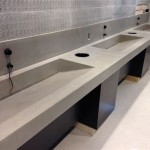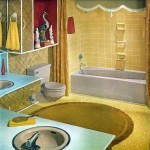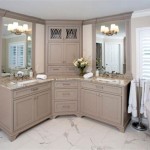Elevating Bathroom Aesthetics: Creative Tile Ideas for Bathroom Walls
The bathroom, often conceived as a purely functional space, presents a significant opportunity for design expression. Walls, in particular, offer a expansive canvas for incorporating style and personality. Tile, prized for its durability, water resistance, and aesthetic versatility, emerges as a leading material for transforming bathroom walls. This article explores a diverse range of tile ideas suitable for bathroom walls, focusing on materials, patterns, colors, and installation techniques that can significantly enhance the overall bathroom environment.
Understanding Tile Materials and Their Properties
Selecting the appropriate tile material is paramount to achieving both the desired aesthetic and long-term performance. Various materials are available, each possessing unique characteristics that influence their suitability for bathroom applications.
Ceramic Tile: Ceramic tile represents a widely accessible and cost-effective option. Composed of clay fired at high temperatures, ceramic tile is inherently water-resistant, making it a practical choice for bathroom walls. Its versatility extends to design, with numerous colors, patterns, and sizes available. However, ceramic tile tends to be less durable than porcelain tile and may be more prone to chipping or cracking under significant impact.
Porcelain Tile: Porcelain tile, a refined version of ceramic, boasts enhanced durability and water resistance. Fired at even higher temperatures than ceramic, porcelain exhibits a lower water absorption rate, rendering it effectively impervious to moisture. This makes porcelain tile particularly suitable for areas prone to frequent water exposure, such as shower walls. Furthermore, porcelain tile's robust nature renders it highly resistant to scratching, staining, and fading.
Glass Tile: Glass tile introduces a sleek and sophisticated aesthetic to bathroom walls. Its reflective surface enhances the play of light, creating a sense of spaciousness, particularly in smaller bathrooms. Glass tiles are non-porous, ensuring excellent water resistance. They are available in a wide spectrum of colors and sizes, allowing for intricate mosaic designs or minimalist, contemporary installations. However, glass tile can be more expensive than ceramic or porcelain and may require specialized installation techniques.
Natural Stone Tile: Natural stone, including materials like marble, granite, and slate, imparts a luxurious and organic feel to bathroom walls. Each stone possesses unique veining and patterns, offering unparalleled visual appeal. Marble exudes elegance and sophistication, while granite provides durability and resilience. Slate offers a more rustic and textured appearance. While natural stone tile elevates the aesthetic, it typically requires sealing to prevent staining and water damage. Certain types of natural stone may also be more porous than other tile materials.
Subway Tile: Subway tile, characterized by its rectangular shape and typically glossy finish, is a timeless classic. Traditionally white, subway tile is increasingly available in a variety of colors and finishes, allowing for diverse design interpretations. Its clean lines and simple design render it versatile enough for both traditional and contemporary bathroom styles. Subway tile is often arranged in a horizontal offset pattern, but alternative layouts, such as vertical stacking or herringbone patterns, offer unique visual interest.
Exploring Diverse Tile Patterns and Layouts
Beyond material selection, the arrangement of tiles significantly influences the overall visual impact of a bathroom wall. The following explores diverse pattern and layout options that can elevate the aesthetic appeal of bathroom tile designs.
Horizontal Offset (Brick Pattern): This classic pattern, commonly associated with subway tile, involves staggering rectangular tiles in a brick-like arrangement. The slight offset creates subtle visual interest and is easy to install. This pattern is particularly effective for visually lengthening a wall or making a small bathroom appear wider.
Vertical Stacked: A modern and minimalist pattern, vertically stacked tiles create a clean and linear aesthetic. This layout is well-suited for creating a sense of height, making it a good choice for bathrooms with lower ceilings. Dark grout lines against light-colored tiles can further accentuate the verticality of this pattern.
Herringbone: The herringbone pattern involves arranging rectangular tiles in a V-shaped, zigzagging design. This creates a dynamic and visually captivating effect. Herringbone patterns can be more challenging to install than simpler layouts but offer a significant aesthetic reward. This pattern works particularly well as an accent wall or in smaller areas such as a shower niche.
Chevron: Similar to herringbone, the chevron pattern incorporates tiles cut at an angle to create a continuous zigzag design. This pattern offers a more streamlined and contemporary appearance compared to the herringbone layout. Chevron patterns are often used to create a focal point or highlight a specific area within the bathroom.
Mosaic: Mosaic tile consists of small tiles arranged in intricate patterns or images. Mosaic tile can be used to create decorative borders, accent walls, or entire wall coverings. Mosaic tile provides an opportunity for personalization and artistic expression. Glass mosaics, in particular, can add vibrancy and dimension to the bathroom space.
Large Format Tiles: Large format tiles, characterized by their larger size, offer a sleek and modern aesthetic. They minimize grout lines, creating a cleaner and more seamless appearance. Large format tiles can make a small bathroom appear larger by reducing visual clutter. These tiles are available in a variety of materials, including porcelain, ceramic, and natural stone.
Geometric Patterns: Incorporating geometric patterns through tile arrangement allows for the creation of visually striking and contemporary designs. Hexagon tiles, triangles, or squares can be combined to form intricate and unique patterns. Geometric patterns can be used to define zones within the bathroom or create a focal point.
Color Palettes and Design Considerations for Bathroom Wall Tiles
Color plays a crucial role in shaping the overall mood and ambiance of a bathroom. The selection of tile colors should complement the existing fixtures, lighting, and overall design aesthetic. Consider the following color palette and design ideas when selecting your bathroom wall tiles.
Neutral Hues: Neutral colors, such as white, beige, gray, and cream, provide a timeless and versatile backdrop for bathroom walls. These colors create a sense of calm and serenity, making them ideal for relaxation. Neutral hues also offer flexibility in decorating, as they can be easily paired with a variety of accent colors and accessories. White tile is a particularly popular choice for its clean and bright aesthetic, which can make a small bathroom appear larger.
Bold Colors: Incorporating bold colors, such as blue, green, red, or yellow, can add vibrancy and personality to a bathroom. Bold colors can be used as accent walls, in mosaic tile patterns, or as a border to draw attention to specific areas. When using bold colors, it is important to balance them with neutral tones to prevent the space from feeling overwhelming. Consider the psychological effects of different colors when selecting your palette; for example, blue is often associated with tranquility, while green evokes a sense of nature and freshness.
Monochromatic Schemes: A monochromatic color scheme involves using different shades and tones of a single color. This creates a cohesive and sophisticated look. For example, a monochromatic blue scheme could incorporate light blue tiles for the main walls, darker blue tiles for an accent wall, and navy blue accessories. Monochromatic schemes can be particularly effective in creating a sense of calm and unity within the bathroom.
Contrasting Colors: Utilizing contrasting colors can create visual interest and drama in a bathroom. Pairing opposing colors, such as black and white, blue and orange, or green and red, creates a dynamic and eye-catching effect. Contrasting colors can be used to highlight architectural features, define zones within the bathroom, or create a focal point. When using contrasting colors, it is important to consider the balance and proportion of each color to achieve a harmonious design.
Textured Tiles: Textured tiles add depth and dimension to bathroom walls. Textured tiles can mimic the look of natural materials, such as wood, stone, or fabric, or feature geometric patterns and raised surfaces. Textured tiles add tactile interest to the bathroom and can create a more inviting and comfortable atmosphere. When using textured tiles, it is important to consider their maintenance requirements, as some textured surfaces may be more difficult to clean.
Grout Considerations: Grout plays a crucial role in the overall aesthetic of tile walls. The color and width of grout lines can significantly impact the appearance of the tile installation. Lighter grout colors can blend seamlessly with light-colored tiles, creating a clean and uniform look. Darker grout colors can contrast with light-colored tiles, highlighting the tile pattern and adding visual interest. Epoxy grout is a durable and water-resistant option that is less prone to staining and mildew growth. Select a grout color that complements the tile selection and overall design aesthetic.
Lighting Integration: Proper lighting is essential for showcasing tile designs effectively. Strategically placed lighting can accentuate the texture, color, and pattern of the tiles. Consider incorporating recessed lighting, vanity lighting, and accent lighting to create a well-lit and visually appealing bathroom space. Under-cabinet lighting can highlight the flooring and create a sense of spaciousness. Dimmable lighting allows for adjusting the ambiance and creating a relaxing atmosphere.
By carefully considering the material, pattern, color, and lighting choices, homeowners can transform their bathroom walls into visually stunning and functional features, enhancing the overall bathroom experience.
:max_bytes(150000):strip_icc()/milesminnophotography_118311492_318343026165812_2272495376046156320_n-669492e1adc2421491187072dc287d7e.jpg?strip=all)
62 Beautiful Bathroom Tile Ideas For Walls Floors And More

40 Chic Bathroom Tile Ideas Wall And Floor Designs

Bathroom Porcelain Tile Walls Design Photos And Ideas Dwell
21 Essential Bathroom Tile Design Ideas

Bathroom Wall Tiles Design Ideas Designcafe

20 Popular Bathroom Tile Ideas Wall And Floor Tiles

Creative Bathroom Tile Design Ideas Tiles For Floor Showers And Walls In Bathrooms

Bathroom Tile Ideas 17 Inspiring Design For Your Home Décor Aid

Bathroom Shower Tile Ideas

10 Bathroom Floor Wall Tile Ideas Bridport Glass Centre
Related Posts







